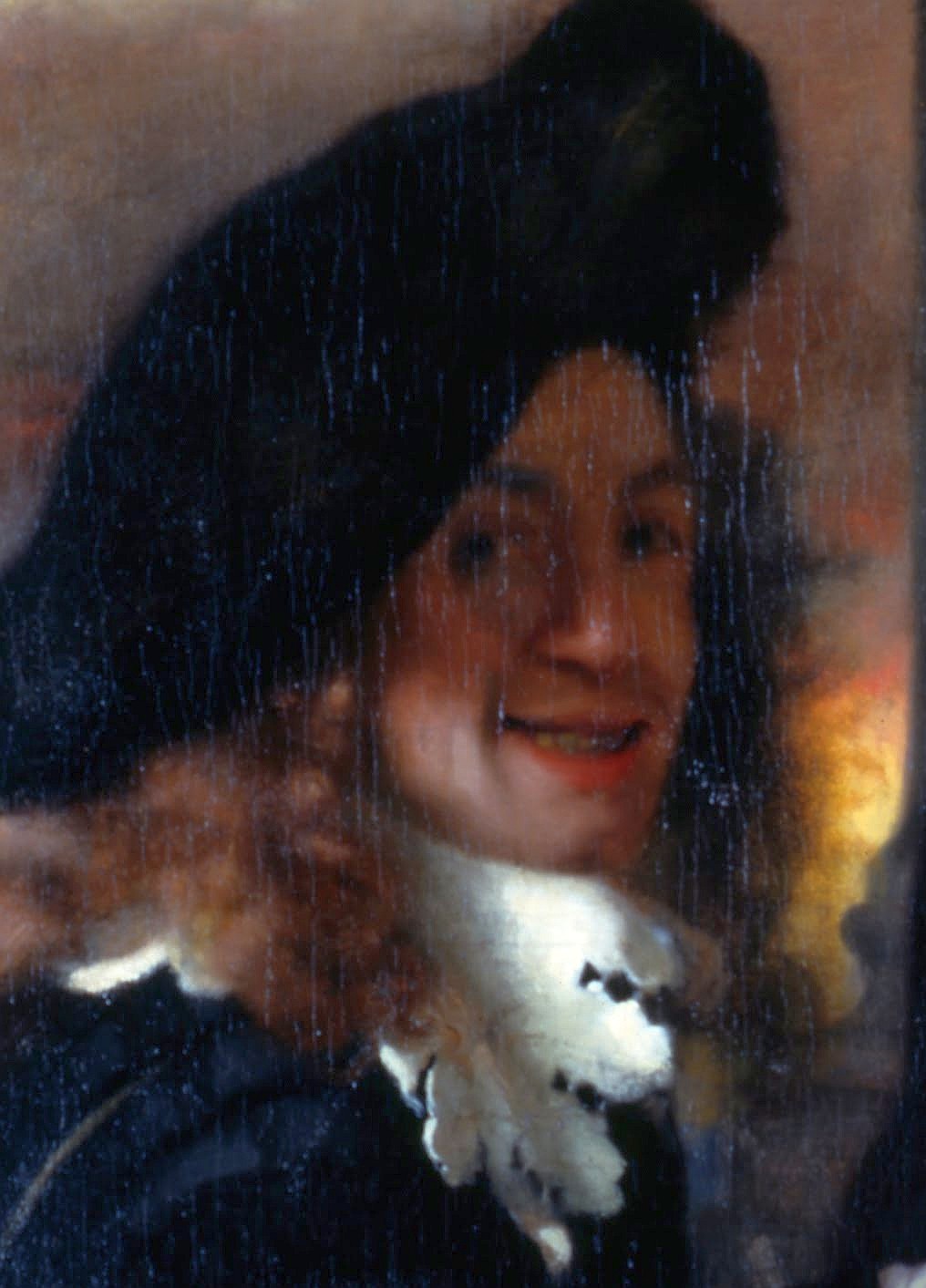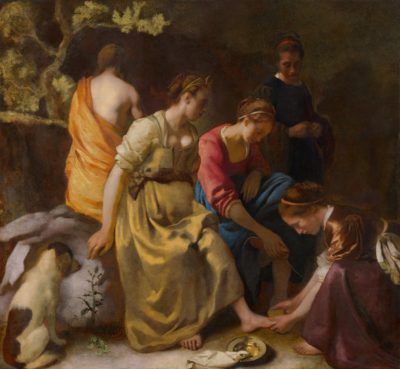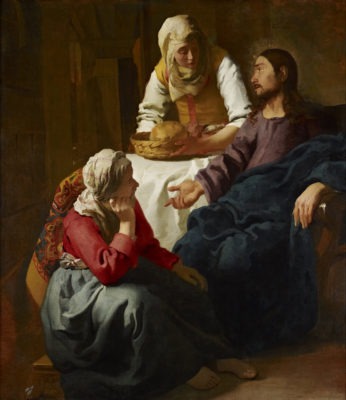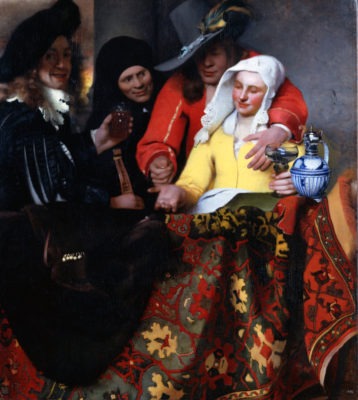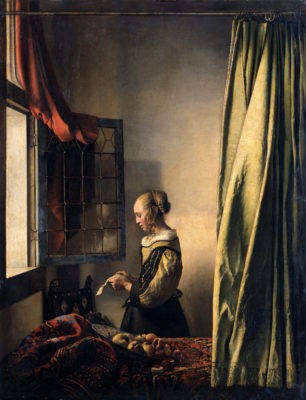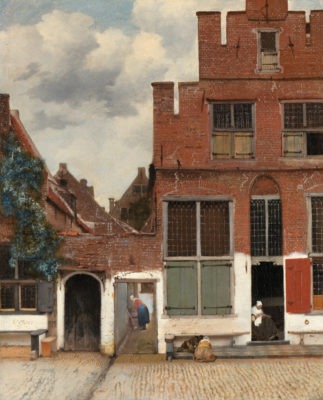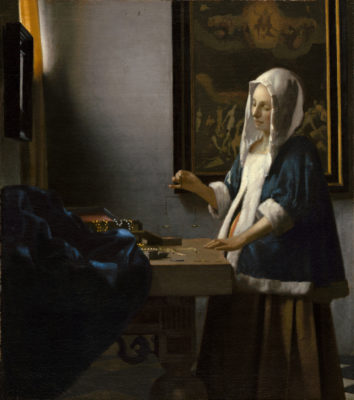Johannes Vermeer, also spelled Jan, was a Dutch painter who produced some of its most treasured
and renowned images in art history. He was born in Delft in October 1632 and died in the same place 32 years later on 16 December 1675.
He was a Dutch Baroque painter specialized in intimate interior scenes of middle-class life throughout the 17th century. The purity of light and shape in these pieces is outstanding, conveying a peaceful, timeless sense of dignity. Vermeer also painted allegorical subjects and cityscapes. He was a reasonably successful provincial genre painter who was well-known in Delft and The Hague during his lifetime. Despite this, he only made a few paintings and was not affluent, leaving his wife and children in debt when he died.
Only roughly 36 of his paintings have survived, but they are among the greatest treasures in the world’s most prestigious museums. Vermeer began his career painting large-scale biblical and mythical subjects in the early 1650s.
Early Life
Mid-seventeenth century, the city where Vermeer was born was a bustling and wealthy town. Thanks to its thriving delftware industries, tapestry-weaving ateliers, and breweries. The structure had Delft’s city walls surrounded by picturesque waterways and a market square flanked by the majestic town hall and the soaring spire of the Nieuwe Kerk (“New Church”).
It was also an illustrious city with a long and illustrious history. Delft’s strong defenses, city walls, and medieval gates had provided security for more than three centuries. Further, it had given refuge for William I, Prince of Orange, from 1572 until he died in 1584, during the Dutch resistance against Spanish domination.
In the Nieuwe Kerk, Vermeer was baptised. Reynier Jansz, his father, was a weaver who made an exquisite satin cloth called caffa and worked as an art dealer. By 1641, the family had amassed enough wealth to purchase the Mechelen, a large house with an inn on the market square. When his father died in October 1652, Vermeer inherited both the inn and the art-dealing company. Vermeer, on the other hand, decided by this time that he wanted to be a painter.
Johannes Reijniersz Vermeer married Catharina Bolenes, a Catholic woman, in April 1653. (Bones). The blessing took place in the peaceful village of Schipluiden, not far away. Maria Thins, Vermeer’s new mother-in-law, was substantially wealthier than he was. It was most likely she who insisted on Vermeer converting to Catholicism before the wedding on 5th April.
Between 1670 and 1672, he painted The Allegory of Faith, which focused less on the artist’s realistic themes and more on symbolic religious implications, particularly the sacrament of the Eucharist. Following that decade, Vermeer and his wife moved into the home of the girl’s mother, Maria Thins, a distant relative of Abraham Bloemaert, a Utrecht painter.
Artistic Training and Early Influence
Surprisingly little information exists about Vermeer’s desire to pursue a career as a painter. On December 29, 1653, he became a master painter in the Delft Guild of Saint Luke, although the name of his master(s), the nature of his training, and the length of his apprenticeship are all unknown.
Although Vermeer’s name does not appear in Delft’s archival documents during the late 1640s or early 1650s, possible that he moved to Italy, France, or Flanders, as many aspiring Dutch artists did.
In France, he might have studied in another Dutch creative center, such as Utrecht or Amsterdam. Vermeer would have met painters in Utrecht who were absorbed in Caravaggio’s boldly expressive traditions, such as Gerrit van Honthorst. He would have reached the influence of Rembrandt van Rijn in Amsterdam, whose vivid chiaroscuro effects intensified the psychological intensity of his paintings.
Early large-scale religious and mythical paintings by Vermeer, such as Diana and Her Nymphs, display artistic elements from both the Utrecht school and Rembrandt’s.
Moreover, like Diana and her nymphs, Vermeer had another famous artwork known as Christ in the House of Mary and Martha.
Suggested Post: famous unfinished works
In Vermeer’s painting, the most remarkable fusion of the two traditions exists in The Procuress (1656). The topic of this mercenary love scene seems inspired by a painting by Utrecht-school artist Dirck van Baburen in Vermeer’s mother-in-collection the law’s. However, the bright reds, yellows, and powerful chiaroscuro effects are evocative of Rembrandt’s technique.
The dimly lighted figure in the composition’s left corner is most likely a self-portrait in which Vermeer plays the Prodigal Son, a role that Rembrandt had also played in one of his own “merry company” pieces.
In the early 1650s, Vermeer would have received a lot of inspiration in his hometown of Delft, where art was changing rapidly. Leonard Bramer was the most significant artist in Delft at the period. Not only small-scale history paintings—morally edifying portrayals of biblical or mythological subjects—but also massive murals for the prince of Orange’s court. According to documents, Bramer, a devout Catholic, was a witness at Vermeer’s marriage. Although it appears that Bramer was at the very least an early supporter of Vermeer, there is no indication that he was his teacher.
Carel Fabritius, a former Rembrandt disciple, was another famous painter Vermeer must have known in Delft at the time. Vermeer appears to have been greatly affected by Fabritius’ evocatively somber images and inventive use of perspective. The poet Arnold Bon highlighted this connection while writing about Fabritius’ terrible demise in the Delft powder-house explosion in 1654, stating that “Vermeer expertly stepped in [Fabritius’] path.” Even though Vermeer was aware of Fabritius’ work, there is no indication that he studied with him.
Whatever the circumstances of his early creative schooling, Vermeer began to represent scenes of everyday life in the second half of the 1650s. These are the genre paintings with which he is most frequently associated. Gerard Terborch an artist, known for his mastery of texture in depictions of household occupations, may have pushed Vermeer to paint scenes of ordinary life.
Girl Reading a Letter at an Open Window (c. 1659), one of Vermeer’s early genre paintings, shows Terborch’s influence in creating a tranquil area for the young woman to read her letter.
Vermeer, in contrast to Terborch’s usual dark interiors, bathed the picture in a dazzling light. It floods in via an open window. Vermeer’s rising interest in illusionism resulted in the inclusion of a yellowish-green curtain hanging from a rod running across the top of the painting, as well as the weak reflections of the woman’s face in the open window.
During this time, Vermeer’s interior scenes got influenced by Pieter de Hooch, a famous genre painter in Delft. De Hooch mastered the use of perspective to create a light-filled interior or courtyard scene with comfortable figures.
Despite the lack of documentation linking Vermeer and de Hooch, the two painters were likely in close contact during this time, given the subject matter and style of their paintings at a time.
Vermeer’s View of Houses in Delft (c. 1658; also known as The Little Street) is one such work: like de Hooch’s courtyard scenes, Vermeer has depicted a world of domestic peace, in which women and children go about their everyday lives in the safe confines of their homes.
Johannes Vermeer’s Maturity
Vermeer’s best paintings, the majority of which are interior scenes, were created over the space of about a decade in the late 1650s. A relatively quick time of activity, given the enormity of his reputation. Therefore no early Dutch painter created scenes with the same luminosity or purity of color. Moreover, no other painter’s work had the same sense of timelessness and human dignity.
Vermeer became well-known in his hometown of Delft when he reached the pinnacle of his abilities, and in 1662 he was chosen head of the painters’ guild. Although no commissions for Vermeer’s paintings got documented, it appears that he sold his work primarily to a small group of Delft clientele during this and other times. Over two decades after Vermeer’s death, the estate of Jacob Dissius, a Delft collector, sold no fewer than 21 of his works.
Themes
Vermeer found ways to communicate a sense of inner harmony within ordinary life. Particularly in the limits of a private chamber, in paintings representing women reading or writing letters, playing musical instruments, or decorating themselves with jewels, during the height of his career.
In paintings like Young Woman with a Water Pitcher and Woman with a Pearl Necklace, he used the laws of perception and the installation of specific items, tables, window frames—to create a sense of nature’s implicit order (c. 1663).
Even though his mature work took inspiration from his views of ordinary life, Vermeer remained a historical painter at heart, attempting to conjure abstract moral and philosophical themes. A woman holding a balance is an exceptional example of this characteristic (c. 1664).
Methods of Work
The brilliance of Vermeer’s best paintings is perhaps their most distinctive attribute. Vermeer used a grey or ochre base layer over his canvas or panel support to construct.
As a result of his use of microscopic dots of unmodulated color, paintings appear to be pervaded by a sensation of light. Vermeer’s diffuse highlights are similar to those found in a camera obscura, an intriguing optical apparatus that works similarly to a box camera. Vermeer got reportedly attracted by optical phenomena to enhance the sensation of immediacy in his paintings.
Several have suggested that Vermeer used the camera obscura to plan his compositions, even tracing the images projected on the background glass. However, this was not true. He had to have spent his time thinking about the character of his artwork and how he wanted to show it.
Later Life
Vermeer got re-elected as head of the Delft painting guild in 1670. In contrast to his paintings from the 1660s, Vermeer’s late style is crisper, with greater atmospheric clarity. Around 1670, the delicately modulated tones and colors of his earlier works gave a powerful approach. The artist’s finances plummeted at the end of his life, owing primarily to the disastrous economic climate in Holland following the French invasion in 1672. Vermeer left a wife, 11 children, and massive debts when he died in 1675.
Bottom Line
For two centuries after his death, art historians mainly ignored Vermeer’s works. Vermeer’s works and reputation have got featured in literature and entertainment.

